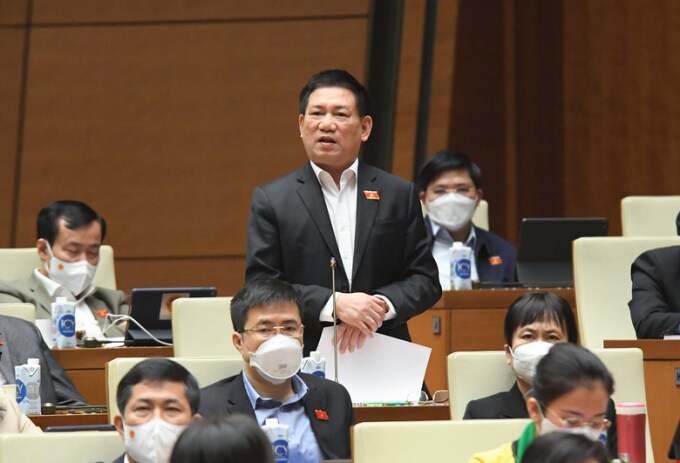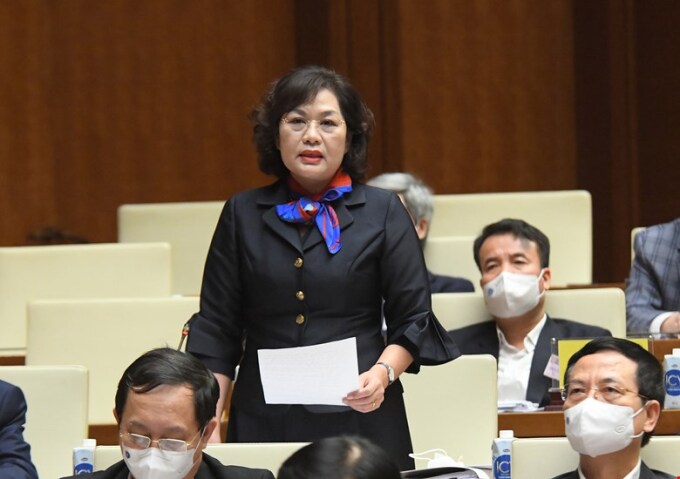Vietnam Gov’t plans to mobilize US$8 billion via G-bonds next 2 years to aid growth
Such an amount would be used to finance economic recovery plans.
The Vietnamese Government is considering mobilizing VND180 trillion (US$8 billion) in the next two years to finance economic recovery plans.
| Minister of Finance Ho Duc Phoc at the session. Source: quochoi.vn |
Minister of Finance Ho Duc Phoc gave the view during a National Assembly discussion session held on November 12.
Phoc added another supporting package by financing lending rates for enterprises worth VND20 trillion ($884 million) per year for the 2022-2023 period is on the cards. The minister estimated such a program would help inject an addition of VND1,000 trillion ($44 billion) into the economy.
“Such an amount should be used for creating jobs and pushing for production/investment, in turn lowering fiscal deficits in subsequent periods,” he added.
Meanwhile, Phoc said the ministry would continue to propose the extension of supporting policies of waiving and freezing payments of taxes and fees, which so far has amounted to VND115 trillion ($5.06 billion); 30% cut in value-added and corporate income taxes; or waiving tax penalties.
“On another hand, the authorities would focus on collecting taxes of online businesses and promoting the use of e-invoices to ensure effective tax management,” Phoc added.
The main issue, Phoc said, is how the economy could absorb such a huge amount of capital, and also on which sectors.
“Capital should be channeled to public projects and economic sectors with high spillover effects and to increase budget revenue in the future,” Phoc said, stressing the necessity of accelerating the construction of large-scale projects for fast disbursement of public funds.
Phoc noted the rate of public debt to GDP pre-adjustment is estimated at 56.8% in 2021, below the statutory limit of 60% but higher than the warning threshold of 55%.
In this regard, Minister of Planning and Investment Nguyen Chi Dung noted supporting programs should not only address short-term issues of both the supply and demand sides but also stay in line with Vietnam’s long-term development targets.
“Such programs should be conducted in a flexible manner for adjustment if necessary and meet actual needs of beneficiary groups,” he said.
Dung also stressed the necessity for these programs to ensure macro-economic stability, national financial security, as well as within the capability of the economy.
| SBV Governor Nguyen Thi Hong. |
High inflationary pressure in 2022
Drawing on the lessons learned from the 2008-2009 economic crisis, Governor of the State Bank of Vietnam (SBV) Nguyen Thi Hong expected high inflationary pressure in 2022, which would require flexible management of monetary policy.
“The inflation rate in 2021, however, is still on track to stay below the 4% target,” Hong said.
Given the recovery of the global economy and prices of goods are on the rise, especially petroleum products, Hong noted a number of developed countries have seen record-high inflation rates such as the US with consumer price index (CPI) expanding by 6.2% in October, the highest since 1990, South Korea by over 3%, the highest since 2012, or the rate in Europe in September was at the highest in the past 13 years.
“Vietnam’s economy with a high level of openness could be exposed to imported inflation,” Hong continued, referring to the growing number of central banks in the world that have been adopting easing monetary policies.
Hong also expressed concern over rising bad debts in the banking sector as banks are using their own resources to lower lending rates for customers.
“The SBV is committed to creating conditions for banks to further lower their lending rates, but also ensuring the safety of the banking system,” she continued.
According to Hong, since 2020, the SBV has decided to cut policy rates three times for combined rates of 1.5-2% per annum, saying the cut is among the largest in the region.
To date, the average lending rate in the market has been lowered by 1.66% compared to the pre-pandemic period, with banks foregoing around VND30 trillion ($1.32 billion) in interest rates.













